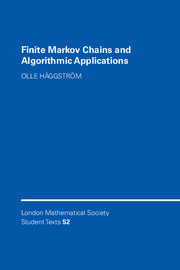Book contents
- Frontmatter
- Contents
- Preface
- 1 Basics of probability theory
- 2 Markov chains
- 3 Computer simulation of Markov chains
- 4 Irreducible and aperiodic Markov chains
- 5 Stationary distributions
- 6 Reversible Markov chains
- 7 Markov chain Monte Carlo
- 8 Fast convergence of MCMC algorithms
- 9 Approximate counting
- 10 The Propp–Wilson algorithm
- 11 Sandwiching
- 12 Propp–Wilson with read-once randomness
- 13 Simulated annealing
- 14 Further reading
- References
- Index
3 - Computer simulation of Markov chains
Published online by Cambridge University Press: 29 March 2010
- Frontmatter
- Contents
- Preface
- 1 Basics of probability theory
- 2 Markov chains
- 3 Computer simulation of Markov chains
- 4 Irreducible and aperiodic Markov chains
- 5 Stationary distributions
- 6 Reversible Markov chains
- 7 Markov chain Monte Carlo
- 8 Fast convergence of MCMC algorithms
- 9 Approximate counting
- 10 The Propp–Wilson algorithm
- 11 Sandwiching
- 12 Propp–Wilson with read-once randomness
- 13 Simulated annealing
- 14 Further reading
- References
- Index
Summary
A key matter in many (most?) practical applications of Markov theory is the ability to simulate Markov chains on a computer. This chapter deals with how that can be done.
We begin by stating a lie:
In most high-level programming languages, we have access to some random number generator producing a sequence U0, U1, … of i.i.d. random variables, uniformly distributed on the unit interval [0, 1].
This is a lie for at least two reasons:
(A) The numbers U0, U1, … obtained from random number generators are not uniformly distributed on [0, 1]. Typically, they have a finite binary (or decimal) expansion, and are therefore rational. In contrast, it can be shown that a random variable which (truly) is uniformly distributed on [0, 1] (or in fact any continuous random variable) is irrational with probability 1.
(B) U0, U1, … are not even random! Rather, they are obtained by some deterministic procedure. For this reason, random number generators are sometimes (and more accurately) called pseudo-random number generators.
The most important of these objections is (B), because (A) tends not to be a very big problem when the number of binary or decimal digits is reasonably large (say, 32 bits). Over the decades, a lot of effort has been put into constructing (pseudo-)random number generators whose output is as indistinguishable as possible from a true i.i.d. sequence of uniform [0, 1] random variables.
Information
- Type
- Chapter
- Information
- Finite Markov Chains and Algorithmic Applications , pp. 17 - 22Publisher: Cambridge University PressPrint publication year: 2002
